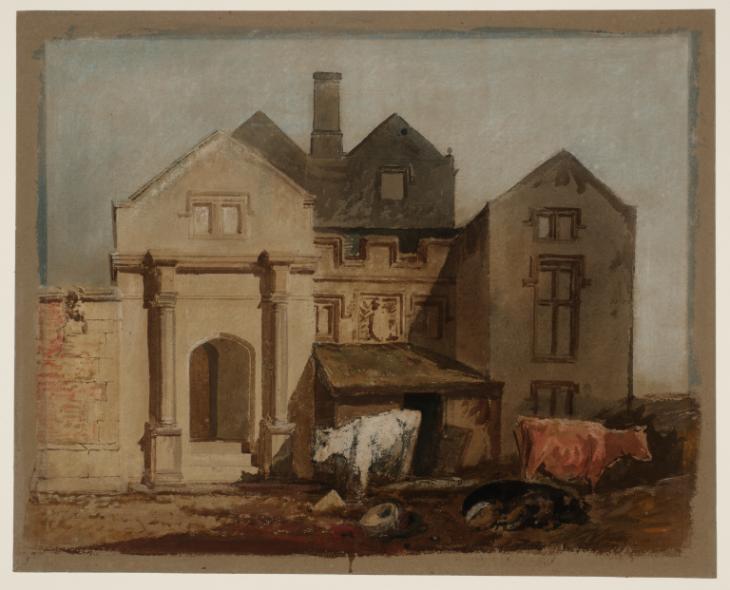Joseph Mallord William Turner Newall Old Hall, Otley, near Farnley Hall c.1808
Joseph Mallord William Turner,
Newall Old Hall, Otley, near Farnley Hall
c.1808
Joseph Mallord William Turner 1775–1851
Newall Old Hall, Otley, near Farnley Hall c.1808
D12114
Turner Bequest CLIV P
Turner Bequest CLIV P
Chalk, gouache, pencil and watercolour on heavyweight brown paper, 439 x 542 mm
Accepted by the nation as part of the Turner Bequest 1856
Exhibition history
1878
National Gallery, London, various dates 1878–1904 (550).
1937
Sixty Pictures of Yorkshire Scenery, Leeds City Art Gallery, June–August 1937 (52).
1938
Display of Watercolours, National Gallery, London, December 1938–September 1939 (no catalogue).
1979
Turner and the Country House View Tradition: Watercolours and Sketches from the Turner Bequest Loaned by the British Museum, Tate Gallery, London, January–June 1979 (no catalogue).
1980
Turner in Yorkshire, York City Art Gallery, June–July 1980 (58 as ‘Newall Old Hall, Otley, c.1814?’).
References
1909
A.J. Finberg, A Complete Inventory of the Drawings of the Turner Bequest, London 1909, vol.I, p.437, CLIV P, as ‘Newall Hall, near Farnley.... Over doorway “Anno D. 1620” (? 1624)’.
1937
Sixty Pictures of Yorkshire Scenery, Leeds City Art Gallery 1937, no.52.
1979
Andrew Wilton, The Life and Work of J.M.W. Turner, London 1979, p.373, no.630.
1980
David Hill, Stanley Warburton, Mary Tussey and others, Turner in Yorkshire, exhibition catalogue, York City Art Gallery 1980, p.42 (no.58 as ‘Newall Old Hall, Otley).
1982
Stanley Warburton, Turner and Dr. Whitaker, exhibition catalogue, Towneley Hall Art Gallery & Museums, Burnley 1982, no.36.
Newall Old Hall stood just to the east of the road from Otley to Blubberhouses, about half a mile north of Otley Bridge, and three quarters of a mile south-west of Farnley Hall, the seat of Turner’s patron Walter Fawkes. It is recorded in the possession of the Fawkes family in 1275.1 It consisted of a two bay four-storey twin-gabled pele tower, possibly dating back to the fifteenth or sixteenth century, with a central chimney stack (seen here in the background). On to this was grafted a wide range of extensions. The porch here was built in 1624. In 1814 it was dismantled and removed to Farnley Hall to serve as the entrance to the flower garden, where it remains today.
Finberg was not altogether sure of the date of its original construction, also giving it as 1620, but 1624 is confirmed by Turner’s record of it, still in situ at Newall, in the Devon Rivers No.2 sketchbook (Tate D09673–D09674; Turner Bequest CXXXIII 4a–5). A later sketch of the porch as reconstructed at Farnley in the Devonshire Rivers, No.3, and Wharfedale sketchbook (Tate D09790; Turner Bequest CXXXIV 1a) is related to one of the Farnley Hall series of gouaches, sometimes called ‘Front Door and Porch, Farnley’ (private collection)2 and an etching entitled in its inscription ‘Flower Garden Porch at Farnley Removed from Newhall AD 1814’.3 Newall appears in a parlous condition in Turner’s views, with random later accretions including the cow byre depicted here. The removal of the porch in 1814 involved the removal of the crenellations and escutcheon also visible here, so the depredation of the building at that time must have been significant. The old wings were swept away in 1827 and new wings added to the core, and this structure survived until the wings were removed between 1908 and 1921 and the central tower demolished between 1921 and 1934. The site is now a playground and playing fields.4
A gouache of Newall Old Hall from the same angle was painted by Turner for Walter Fawkes about 1816–18 (private collection).5 Ultimately this seems to have derived from the sketch in Devon Rivers 2. The present writer and other scholars proposed a date of c.1814 for the Bequest colour study on the assumption that it was an intermediate rehearsal for the Fawkes gouache. However, the relationships are perhaps worth reconsidering. Although the three images are generally similar, the sketch and Fawkes gouache appear to have been taken from slightly nearer and further right of the viewpoint of the present study. It is also worth observing that the chimney stack is much broader in the Devon Rivers No.2 sketch than in the present work, suggesting some interval between them in which alterations have taken place.
Further comparison indicates that the Bequest colour study more clearly comprehends the architectural relations than either the sketch or the Fawkes gouache The two near gables are in the same plane, and the porch is an add-on to the left gable. The doorway visible through the porch is let into the same wall as the window visible above the porch. This fact is not so clear in the sketch and not at all so in the colour study. Taking this observation in conjunction with the solemnly bucolic atmosphere of the Bequest colour study, it seems a reasonable surmise that the present work dates from an early visit to Farnley, perhaps that of 1808, when Turner appears to have embarked on an extensive programme of sketching out of doors on a large scale.
This is possibly one of Turner’s earlier experiments in painting in gouache on coloured paper, and certainly one of his largest attempts in this medium. There are indications of an unusually careful approach to the subject, the main outline of the building being first ruled in pencil. The cows and the pig and piglets in the foreground seem most typical of Turner’s work from the period 1805 to 1810, and particularly characteristic of subjects made around the Thames.6
Technical notes:
The image must originally have been considerably darker than it is now. The whole painting has faded and lightened within the line of an old window mount, probably when it was exhibited in the nineteenth century.
Verso:
Blank
David Hill
July 2009
How to cite
David Hill, ‘Newall Old Hall, Otley, near Farnley Hall c.1808 by Joseph Mallord William Turner’, catalogue entry, July 2009, in David Blayney Brown (ed.), J.M.W. Turner: Sketchbooks, Drawings and Watercolours, Tate Research Publication, September 2014, https://www

